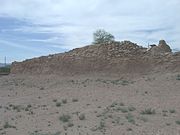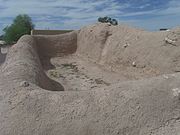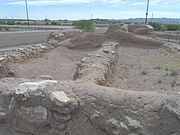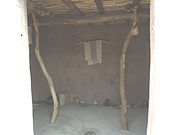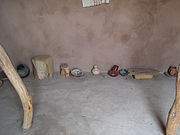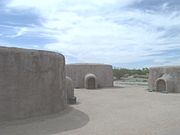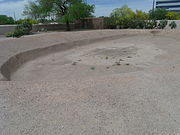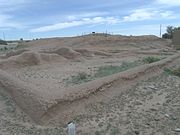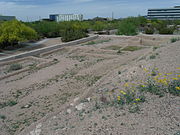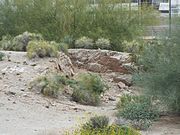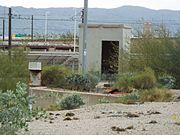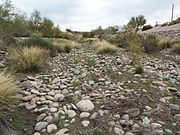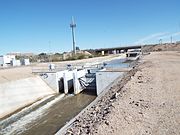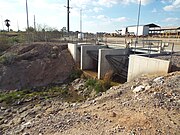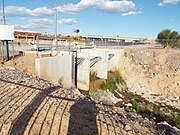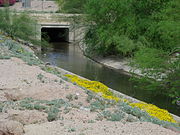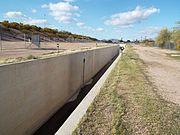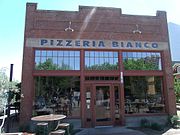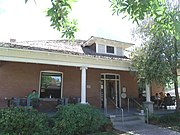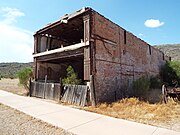
A | B | C | D | E | F | G | H | CH | I | J | K | L | M | N | O | P | Q | R | S | T | U | V | W | X | Y | Z | 0 | 1 | 2 | 3 | 4 | 5 | 6 | 7 | 8 | 9
List of historic properties in Phoenix, Arizona | |
|---|---|
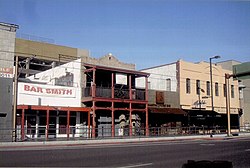 Historic Washington Street | |
 Location in Maricopa County and the state of Arizona |
| Part of a series of the |
| Cities, towns and CDPs in Arizona with lists and images of historic properties, forts, cemeteries or historic districts |
|---|
This is a list, which includes photographic galleries, of some of the remaining historic structures and monuments, of historic significance, in Phoenix, Arizona, United States. Included are photographs of properties identified by the African, Asian and Hispanic historic property surveys of the City of Phoenix, focusing on the themes of history in Phoenix from 1870 to 1975.
This list however, is not limited to historical structures and monuments. Also listed are historical landmarks, some of which are listed in the National Register of Historic Places such as the Pueblo Grande Ruin and Irrigation Sites and the Deer Valley Rock Art Center. These contain the ruins of structures and artifacts of the Hohokams who lived within the modern Phoenix city area before the arrival of the settlers of non-Native American origin.
The abandoned Joint Head Dam and the early canals built by the early pioneers of European descent played an important role in the irrigation and development of Phoenix and its surrounding areas. Pictured is the ruins of the abandoned Joint Head Dam built in 1884. Also, pictured is the Grand Canal, the oldest canal in Phoenix which was built by the pioneers in 1877, and the Old Crosscut Canal, built in 1888.
Included in this list are the photographs of the final resting place of various notable people who are interred in Phoenix's historic cemeteries who were of historical importance to Phoenix and Arizona. According to the definition by the "Pioneers' Cemetery Association (PCA)" a "historic cemetery" is one which has been in existence for more than fifty years. Among the cemeteries listed is the abandoned Crosscut Cemetery which was established in 1870 and therefore, Phoenix's oldest cemetery and the Pioneer and Military Memorial Park, which is listed in the National Register of Historic Places.
Listed are some museums in Phoenix with the images of artifacts of historical importance. Such is the case of the Phoenix Trolley Museum where the historic Trolley Car #116 is showcased. Among the museums are the Martin Auto Museum, which showcases automobiles from 1886 onward and the Musical Instrument Museum.
Laveen and the Sunnyslope District are listed separately because these were two areas whose citizens wanted to proclaim the areas as independent towns, but whose areas were instead merged into the city of Phoenix.
Phoenix

Phoenix is the capital, and largest city, of the U.S. state of Arizona.[1] Phoenix was incorporated as a city in 1881, after being founded in 1867 near the Salt River close to its confluence with the Gila River. The city has numerous historic properties which have been listed in the National Register of Historic Places. There are also 33 landmarks and attractions within Phoenix that are claimed to represent the best features of the city. These have been designated as "Phoenix Points of Pride"[2] and/or are listed in the Phoenix Historic Property Register. The Phoenix Historic Property Register, was established in 1986. It is the city's official listing of the historic and prehistoric properties that have been deemed worthy of preservation. Some of these properties are listed in both the National Register of Historic Places and in the Phoenix Historic Property Register.[3][4][5][6]
Historic Heritage Square is part of the Heritage and Science Park on the east end of downtown. It encompasses the only remaining group of residential structures from the original town site of Phoenix.[7] The images of these properties with a short description of the same are included.
Vanishing Phoenix

According to Robert A. Melikian, author of the book Vanishing Phoenix, Phoenix's preservation office does not have the ability to deny a demolition permit. Therefore, the owner of a property, listed either in the National Register of Historic Places or the Phoenix Historic Property Register, may demolish the historical property.[8] Entire neighborhoods, such as Golden Gate, where members of the minority communities lived have been razed. Both the residence of former Territorial Governor Joseph Kibbey located at 1334 E. Jefferson St. which served as the home and medical practice of Dr. Winston C. Hackett, the first African-American physician in Arizona and the building located at 1342 E. Jefferson St. where Hackett founded the Booker T. Washington Memorial Hospital were demolished.[9][10] The historic St. James Hotel is an example of a building listed in the National Register of Historic Places which will be demolished, despite the protests of preservation groups, to make way for a VIP parking lot for the Phoenix Suns season ticket holders. Among the properties which are listed in the National Register of Historic Places and which have been demolished are the following:[11]
- Arizona Citrus Growers Association Warehouse-601 E. Jackson Street.
- Concrete Block House – 618-620 N. 4th Avenue.
- Higuera Grocery – 923 S. 2nd Avenue.
- Lightning Delivery Co. Warehouse-425 E. Jackson Street.
- Overland Arizona Co. – 12 N. 4th Avenue.
- Judge W. H. Stillwell House – 2039 W. Monroe Street.
- Clinton Campbell House – 361 N. 4th Avenue.
Some of the historic houses and buildings which are listed in the National Register of Historic Places and/ or the Phoenix Historic Property Register are also listed in the "enDangered Dozen Historic Places List," released by the Phoenix Historic Neighborhoods Coalition. These structures are prone to vandalism and the elements. Among the structures which are neglected and are at the highest risk of disappearing in the near future are the following:[12]
- The Steinegger Lodge, built in 1889 and located at 27 E. Monroe St.
- The William R. Norton House, built in 1895 and located at 2222 W. Washington St.
- The Charles Pugh House, built in 1897 and located at 356 N. Second Avenue / 362 N. Second Avenue. (The 356 address is how the records show the house today. It was listed as 362 in older records.)
- The Louis Emerson House, built in 1902 and located at 623 N. Fourth St.
- The Concrete Block Bungalow, built in 1908 and located at 606 N. 9th St.
- The Leighton G. Knipe House, built in 1909 and located at 1025 N. 2nd Avenue.
- The Sach's-Webster Farmstead House, built in 1909 and located in the Northwest corner of 75th Avenue and Baseline.
- The Sarah Pemberton House, built in 1920 and located at 1121 N. 2nd St.
- Mrs. Neal House, built in 1920 and located at 102 East Willetta Street.
Pueblo Grande Ruin
The Pueblo Grande Ruin is the remains of a 450 BC prehistoric Hohokam village. For unknown reasons the site was abandoned by 1450 AD. These are some of the ruins of the Hohokam structures which were unearthed and which are situated in the Pueblo Grande Museum & Archaeological Park.
Listed in the National Register of Historic Places
-
Pueblo Grande Ruin National Historic Landmark Marker. Marker and contents are the work of the US Dept. of the Interior, therefore PD.
-
The Pueblo Grande Ruin Museum is located at 4619 E. Washington St. in Phoenix, Arizona. The ruins are listed in the National Register of Historic Places reference #66000184.
-
Artifacts displayed inside the Pueblo Grande Ruin-Museum
-
Display inside the Pueblo Grande Ruin Museum.
-
Hohokam's of power and influence lived in houses surrounded by mounds.
-
On the sunrise in the summer solstice and in the winter solstice an alignment occurs. A shaft of light stretches from one doorway to another, signaling the mid points of the solar annual cycle.
-
Tools and weapons were stored in these rooms.
-
These rooms were large and had eight foot walls. Artifacts were kept in them.
-
Miller's Room was named after Dr. Joshua Miller, President of Arizona Antiquarian Association, who 1901 conducted the first excavation of the Pueblo Grande Ruins.
-
This is the largest mound in the Pueblo Grande Ruin.
-
This is a representation of what a Hohokam house looked like 700 years ago.
-
Inside view of the Adobe Compound Replica.
-
Artifacts inside of the Adobe Compound Replica.
-
These replicas represent what the Hohokam pit houses looked like 1000 years ago.
-
This was a Hohokam ballpark where they played ceremonial ball games. The villagers stood on top of the surrounding mound to observe the game.
-
Made from mesquite, these kitchens were used by the O'odham people, believed to be descendants of the Hohokam, in the 1600s.
-
The ovens was shared by the Hohokam community.
-
Partial view of the Hohokam Village.
-
Different view of the Hohokam Village.
-
The Old Crosscut Canal was built in 1888 by the pioneers, adjacent to an ancient Hohokam canal which is now filled with soil.
The Joint Head Dam and canals
When the pioneers of European descent settled in Phoenix, the area was mainly desert. Settlers such as Jack Swilling were inspired by the ancient canals of the Hohokam. The pioneers soon began to dig ditches to carry water from the Salt River which would irrigate their farms. Eventually, canal building companies, such as the Arizona Canal Company, which was formed in December 1882, were organized and built the current canals in the area. The Joint Head Dam was built in 1884, where Jack Swilling dug his ditch, known as the "Swillings Ditch", and where the Salt River are located. The dam served the Grand Canal (built 1878) and eventually the Old Crosscut Canal (built 1888). The abandoned Joint Head Dam has been determined to be eligible for inclusion in the National Register of Historic Places under criterion "A" because of its association with the locally important history of reclamation and therefore, is a Section 4 (f) resource.[13]
-
The ruins of the abandoned Joint Head Dam. The joint Head Dam was built in 1884 and repaired in 1913. It is located on a parcel owned by the City of Phoenix, just off 48th Street.
-
The ruins of the abandoned Joint Head Dam.
-
Joint Head Dam ruins.
-
Ruins of the front side of the Joint Head Dam
-
More ruins of the abandoned Joint Head Dam
-
Ruins of the abandoned Joint Head Dam
-
Dried up Salt River bed leading to the Joint Head Dam
-
The dried up section of the Salt River where the abandoned remains of the head gate of the Joint Head Dam is located. This is where Jack Swilling first turned a shovel and established the head of "Swillings Ditch".
-
Grand Canal built in 1878 in Phoenix.
-
The overflow release on the Grand Canal. Built in 1878, it is located near the end of 48th Street on a parcel owned by the City of Phoenix.
-
The other side of the overflow release on the Grand Canal
-
Different view of the overflow release on the Grand Canal
-
The Old Crosscut Canal built adjacent to the Pueblo Grande Ruin in Phoenix.
-
The Old Crosscut Canal was built in 1888.
-
Different view of the 1888 Old Crosscut Canal.
Heritage Square
Phoenix's Heritage Square is located in what once was block 14 of the original townsite of Phoenix. The square dates back to the Victorian era of the late 1800s. The townsite was listed in the National Register of Historic Places on November 7, 1978, reference: #78000550. The Dr. Roland Lee Rosson House (1895), now a Victorian-period historic house museum, and Baird Machine Shop (1920), which are individually listed in the National Register of Historic Places, are also located in the historic square.[14]
-
The Dr. Roland Lee Rosson House was built in 1895 and is located in 139 N. 6th Street in Phoenix. It was added to the National Register of Historic Places in 1971. Reference #71000112
-
The Rosson Carriage House was built in 1899 (PHPR)
-
The Baird Machine Shop built in 1920. It is now part of Phoenix's Heritage Square. It was listed in the National Register of Historic Places in 1985. Reference number 85002047.
-
The Hughe's-Stevens Duplex, built in 1923 (PHPR).
-
The Forest Burgess Carriage House built in 1881 (PHPR)
-
The Stevens House built in 1901 (PHPR)
-
The Bouvier Teeter House built in 1899 (PHPR)
-
The Thomas House was built in 1909. (PHPR)
-
The Stevens-Haugsten House was built in 1901 (PHPR).
Buildings and structures
This section includes historical buildings which are listed either in the National Register of Historic Places or in the Phoenix Historic Property Register. The oldest of these, which is still standing and in use, is the "Fry's Building" which was built in 1885. The oldest hotel, which was completed in 1893, and is still in use today is the "Windsor Hotel".
Also, included in this section are historic structures such as the "Heard Ranch Grain Silos", listed in the PHPR plus, the Arizona State Fair Grandstand which was built in the early 1900s, the "17th Avenue Underpass" and the "Central Avenue Underpass", both which are eligible to be included in the National Register of Historic Places.[15]
(NRHP = National Register of Historic Places)
(PHPR = Phoenix Historic Property Register)
-
What remains of the Phoenix Bakery building. The structure was built in 1881 and was originally located at 7 West Washington Street. The building was donated to the Pioneer Living History Museum in Phoenix. In 2019, the bakery was moved and reassembled at the Phoenix Zoo. [16]Zdroj:https://en.wikipedia.org?pojem=List_of_historic_properties_in_Phoenix,_Arizona
Text je dostupný za podmienok Creative Commons Attribution/Share-Alike License 3.0 Unported; prípadne za ďalších podmienok. Podrobnejšie informácie nájdete na stránke Podmienky použitia.
Antropológia
Aplikované vedy
Bibliometria
Dejiny vedy
Encyklopédie
Filozofia vedy
Forenzné vedy
Humanitné vedy
Knižničná veda
Kryogenika
Kryptológia
Kulturológia
Literárna veda
Medzidisciplinárne oblasti
Metódy kvantitatívnej analýzy
Metavedy
Metodika
Text je dostupný za podmienok Creative
Commons Attribution/Share-Alike License 3.0 Unported; prípadne za ďalších
podmienok.
Podrobnejšie informácie nájdete na stránke Podmienky
použitia.
www.astronomia.sk | www.biologia.sk | www.botanika.sk | www.dejiny.sk | www.economy.sk | www.elektrotechnika.sk | www.estetika.sk | www.farmakologia.sk | www.filozofia.sk | Fyzika | www.futurologia.sk | www.genetika.sk | www.chemia.sk | www.lingvistika.sk | www.politologia.sk | www.psychologia.sk | www.sexuologia.sk | www.sociologia.sk | www.veda.sk I www.zoologia.sk






